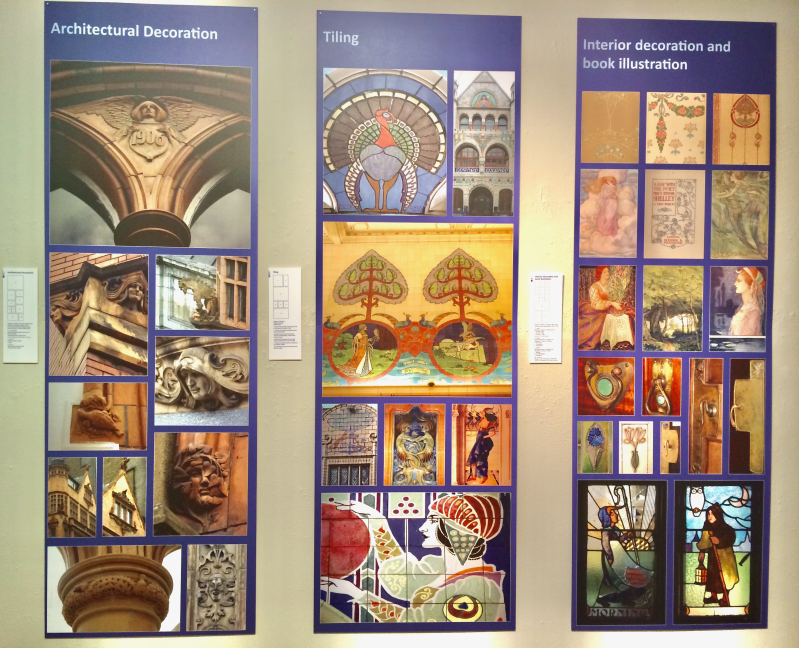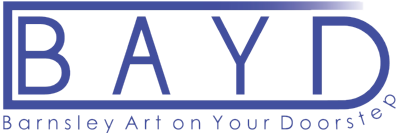
Talks Programme
We organized a programme of five talks with the Friends of the Cooper Gallery to be held at the Cooper Gallery. Barnsley Art on Your Doorstep gave the first talk in May 2014 just before Hidden Art of Barnsley exhibition opened. This was a preview of the exhibition, telling how it came about and describing the great amount of other work that we had been doing in and with local communities as part of the project. The other four talks were by outside speakers.
We were privileged to have attracted four outstanding speakers who were all extremely expert in their field and who showed a very deep knowledge and understanding of their subject. Accordingly their talks were very well received and very well attended. We were most grateful for the time the speakers had given to our project and especially to Elizabeth Barker who was in the UK from the USA where she was based.
An article about the talks was included in our August 2014 newsletter. August 2014 newsletter>>
Talk on Thomas Witlam Atkinson (1799-1861) By Nick Fielding, journalist and writer.
Saturday 14th June 2014
“Undoubtedly one of Britain’s greatest explorers, and yet a man whose name today is barely known”. That is journalist and writer Nick Fielding’s judgement on Thomas Witlam Atkinson, the nineteenth century architect, artist, and traveller in Siberia.
Nick Fielding presented a brief history of the artist and a glimpse into the extraordinary journeys he undertook with his wife and baby child.
Born in 1799 in Cawthorne, just outside Barnsley, the self-taught stone mason turned architect arrived in St Petersburg in the mid-1840s having been inspired by two of the greatest scientists of the age – the formidable Sir Roderick Murchison, president of the Royal Geographical Society and the great German explorer and geographer Alexander von Humboldt.
Having procured an unprecedented blank passport from the Tsar Alexander II allowing him to travel wherever he wanted in Siberia, in 1847 Atkinson made his way by carriage, river barge and horse to the Urals and the remote Altai mountain range in southern Siberia. A year later he returned to St Petersburg but only long enough to marry an English governess, Lucy Sherrard Finley, with whom he set off on a journey that was to last for the next six years.
At the end of their first year of travel Lucy was to give birth in the middle of winter in the bleak steppes of Central Asia. That their son Alatau – named after the mountain range close to where he was born – survived at all is a miracle, but even more extraordinary is the fact that he stayed with the couple for the entire period of their travels, during which they traversed almost 40,000 miles, much of it never before seen by Europeans – or, for that matter by Russians.
During their wanderings, Thomas sketched and painted voraciously, eventually returning to Britain in 1857 with more than 500 watercolours and sketches. Some he had already presented to the Tsar – who in turn presented Thomas with a jewelled ring. Not surprisingly, Thomas’s first book, Oriental and Western Siberia, is dedicated to the Tsar.
On his eventual return to England in 1857 Thomas was lionised by the Establishment, elected to fellowships of the Royal Geographic Society and the Geological Society and spoke on the same platform as the explorer David Livingstone.
But dogged by poor health, Thomas died in 1861, leaving his widow and child almost penniless. He also left them a huge controversy, when it emerged that he had been previously married. He had written on his marriage certificate in Moscow that he was a widower, but his first wife, Rebekah was still very much alive, although she had not seen him for more than 20 years.
More controversy followed when it was alleged that Thomas’s second, rushed, book, was largely based on a book already published in Russian. Both issues were to damage Thomas’s reputation, but Lucy continued to defend him – in her own book - and found many supporters amongst the great and the good, who raised funds for Alatau’s education at Rugby School and who organised a pension for her.
During his talk Nick Fielding presented an impressive slide show of part of the Atkinsons’ journey to give a glimpse into the incredible difficulties they faced in one of the harshest environments in the world.
Since then he has published his research as a book and wishes to thank the people of Barnsley, particularly the young people, who have done so much with their map project to bring the Atkinsons back to life and for celebrating their achievements.
“Thomas may not be well known today, but his achievements remain,” Nick Fielding told the meeting. “Gradually people are rediscovering this remarkable man, warts and all. And Lucy Atkinson is surely one of the most accomplished women travellers of all time. In the end, their story is a human one, full of triumph and not a little tragedy. Their lives are worthy of commemoration.”
Please refer to Nick Fielding’s blog for more information.
Chapter 2: Thomas Whitlam Atkinson in our book >>
Talk on Joseph Wright of Derby, the Tate family of artists, and their connections to Barnsley
Saturday 28th June 2014
Talk on Joseph Wright of Derby, the Tate family of artists, and their connections to Barnsley by Elizabeth E Barker, who was at that time Director of Mead Museum, Amherst College, Massachusetts, USA.
“Joseph Wright of Derby (1737-1797) is one of the most admired European artists of the second half of the 18th century. His masterful depictions of artificial light attracted collectors and taste makers as diverse as Catherine the Great of Russia and Josiah Wedgwood.” (Joseph Wright of Derby in Liverpool, Elizabeth E Barker and Alex Kidson, 2007). He was equally proficient in portraiture, history painting, and landscape. He painted portraits in various northern towns including Retford, Thorne, Doncaster and Eckington. He established a reputation for effects of artificial light with paintings such as An Experiment on a Bird in the Air Pump (1768), and An Iron Forge (1772).
Between 1768 and 1771, in Liverpool, Wright lodged with Richard Tate son of Paul Tate, who was a glassmaker all his working life at Gawber Glass Works near Barnsley. In Liverpool, Wright encountered a group of artists and merchants who would become his lifelong friends and patrons. Wright took on Richard Tate’s younger brother William, born at Gawber, as his pupil from about 1770. The Tates became lifelong friends and agents for Wright. William Tate is recorded as completing Wright’s unfinished paintings afer his death in 1797.
The Liverpool period was a watershed in Wright’s life and work. He changed his methods of design, experimented with new materials, altered his handling of paint and developed new approaches to history painting. Wright records in his letters his (often fraught) engagement with the London art world particularly with the Royal Academy of which he was suspicious and resentful. In fact Wright viewed much of his later work in terms of direct competition with the Academicians. This relationship also affected William Tate his pupil. Wright’s account books record financial transactions that do not concern art - he loaned money throughout his life, typically in the form of bonds and mortgages including to the Tates.
She gave fascinating evidence of the artistic talent of William Tate (1747-1806) and how he had developed his own free flowing style of painting from being Joseph Wright's only professional artist pupil. She gave a vivid account of the bravura of Richard Tate (1736- 1787), an amateur artist who copied some of the most dramatic paintings of the time and exhibited them in Liverpool in the first public exhibitions of art ever outside London. All of Richard's work is undiscovered. She called for a graduate student to take on further research into William Tate to build on that already undertaken.
We were privileged to be having a talk from Elizabeth Barker, as she has done more research about the link between Joseph Wright of Derby and the Tates than probably any other professional. There was a drawing of a glasshouse by Joseph Wright of Derby in the Hidden Art of Barnsley exhibition and three portraits by William Tate.
For Elizabeth Barker’s recent career, find references on Google.
Chapter 1: The Tate Family Of Gawber Hall in our book >>
Talk on William James Neatby (1860-1910)
Saturday 2nd August 2014
Talk on William James Neatby (1860-1910), master of fin-de-siècle art and design in Britain by Scott Anderson MA, PhD, ASFAV, FNAVA
A journey through the career of the Barnsley man who designed the famous tile interior of Harrods Meat Hall and so much more!
One of the best-known tile interiors in Britain is the ceramic extravaganza by W.J. Neatby (1860-1910) in the Food Hall in Harrods Department store in London. His designs for this remarkable building were commissioned by Doulton and Co. of Lambeth, but the project is only one of Neatby’s achievements, as a leading designer in fin-de-siècle Britain. This lecture charted his career from his beginnings as a ceramic artist in Leeds to his time as Head of Doulton’s Architectural Ceramics Department, and beyond.
Topics for study include his graphic work, designs for architectural ceramics, and his work as a book illustrator and wallpaper designer. One of the few designers to work in the Art Nouveau style in England, Neatby created artworks that are still a visual feast for those interested in art and design in the years around 1900. Neatby’s best-known works include tiling in Harrods Food Hall, the Winter Gardens in Blackpool and the Royal Arcade in Norwich.
Chapter 13: William James Neatby in our book >>

The panel of work by William Neatby
The panel of work by William Neatby from the exhibition’s Decorative Art section. Left hand panel (Manchester Art School extension 1897; Salford Education Office in Salford 1895; and 54/55 Cornhill, City of London 1893). Central panel (Tiling from Leicester, Bristol, Harrods Food Hall, London, Blackpool and Norwich). Right hand panel (Book illustration and designs from The Croft, a house in Sunderland)
From Coal to Canvas’, Talk by Imogen Holmes-Roe, Curator of Art and Photography at the National Coal Mining Museum.
Saturday 9th August 2014
The speaker talked about the National Coal Mining Museum’s (NCMM) collection of paintings and the history and development of mining art and artists. She gave a gripping history of how mining had been captured in art, referred to how the New National Coal Board in 1947 had commissioned art works from professional artists and described the lives and art of coal miner artists themselves including George Bissill (1896-1973) and Barnsley born Gilbert Daykin (1886-1939). She showed a fine range of illustrations.
Reference was also made to the following artists: William D. Dring (1904-1990) for his painting “At the Coal Face”(1946), Henry Moore (1898-1986), Hubert Andrew Freeth (1912-1986) for his 1948 painting of miner Herbert Humphrey, Tom McGuinness (1926-2006) and Peter Howson (born 1958).
Link to "Coal & Art" chapter in our book >>
